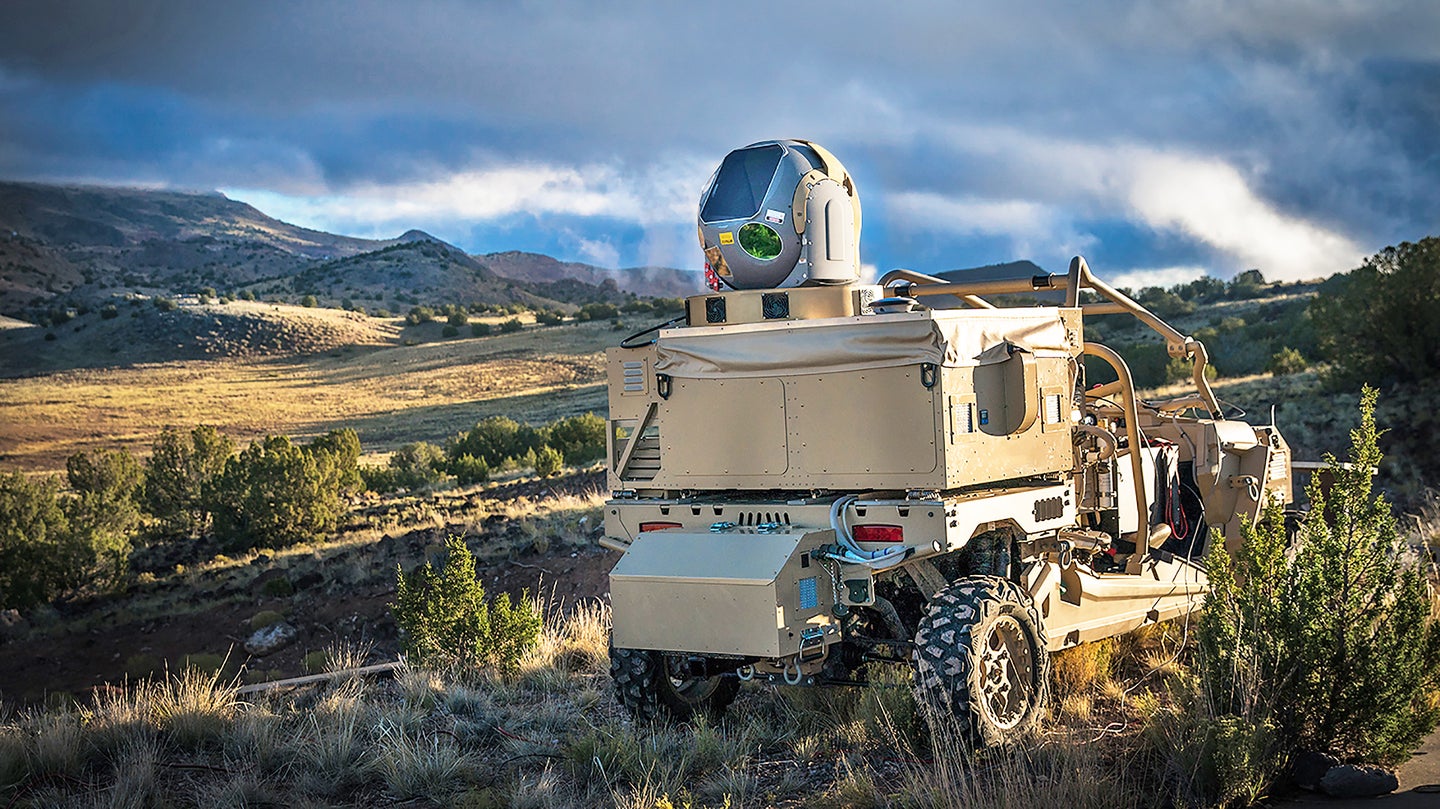
We talk with one of the company's top minds about its buggy-borne High Energy Laser Weapon System and the future of directed energy in combat.
Modern Western militaries face a number of extremely difficult problems as they attempt to modernize rapidly aging armed forces’ equipment and tactics to confront rising threats. For the United States in particular, the services must field capabilities able to deter and if necessary, defeat China and Russia, while also maintaining an ability to rapidly commit forces to confront rogue state threats such as North Korea and Iran. On top of that, they must continue to service global commitments in a host of lower intensity conflicts and contingency scenarios. In trying to equip and sustain forces able to cover this extremely broad range of mission sets, two problems, in particular, are commonly faced in all of them.
This paid article was produced by the Brookline Media Advertising Content Team in partnership with Raytheon.
The first of these problems is inadequate numbers of advanced munitions to service more than a small portion of the required target sets in many potential conflict scenarios. One aspect of this is adversaries from peer states to insurgent groups fielding capabilities which threaten to overwhelm existing defense systems. These threats range from adapted commercial unmanned aerial systems (UAS) to loitering munitions to cheap and numerous indirect fire capabilities. In most cases, the military has high-end missile-based air defense systems theoretically capable of defeating these threats individually. However, magazine limitations means that the sheer number of relatively cheap hostile systems which can be brought to bear threatens to overwhelm these advanced defense systems by weight of numbers.
The second linked problem is that the US military is consistently on the wrong side of the cost curve. Even where sufficient stocks of advanced munitions can be fielded, using missiles that cost hundreds of thousands or even millions of dollars to destroy threats which often cost a few thousand dollars at most is neither efficient, nor potentially sustainable in the face of the rapid increases in the number of small UAS and munitions which can be fielded as already described.
Ideally, what is needed is a capability that can defeat large numbers of massed threats in quick succession, at a cost per shot to allow such a capability to be sustained over time and against a wide range of threat actors in different parts of the world. Directed energy weapons have long been sought as a potential answer to this requirement, but for years have been hampered by high cost, low volume development programs which have sought to tackle some of the hardest problem sets – like ballistic missile defense – as a starting point. However, with the small UAS revolution and the increasing prevalence of loitering munitions in the hands of potential adversaries, several more advanced and much more practical directed energy weapons are now in an advanced stage of testing with the US military.
Raytheon Technologies is behind several of these systems, including the High Energy Laser Weapon System (HELWS), developed by Raytheon Intelligence & Space. Therefore, we sat down with Evan Hunt, their Director of Business Development for High Energy Lasers and Counter-UAS, who is not only an expert on the field, but also brings with him an operational background in the US Air Force as a weapons systems officer.
In the following interview, Evan gave us a fantastic in-depth look at the current state of play with directed energy weapons, particularly on the company’s High-Energy Laser Weapon System, as well as some well-informed predictions for the future:
Justin:
Before diving into detail specific to your high-energy laser weapon system and capabilities, I was wondering if you could give a brief outline of how directed energy fits into Raytheon's overall strategy as a major prime defense contractor.
Evan Hunt:
Directed energy is part of the electronic warfare spectrum, and there are two prominent forms of directed energy, high-energy lasers (HEL) and high power microwaves (HPM). High-energy lasers are silent, invisible beams of light that burn holes in their targets, and high-power microwaves are energy pulses that disrupt controlled electronics. They both have different operational situations that they're desirable for. And both of them have proven to be compelling counter-drone technologies. Raytheon Intelligence & Space has made a strong push in high-energy laser weapon systems developed specifically for the counter-drone mission, and we've had a lot of success in that area. And our Raytheon Missiles & Defense business has advanced and demonstrated the effectiveness of high-powered microwaves in a variety of form factors, large and small.
Justin:
In terms of more mobile directed-energy weapon applications, what progress has been made so far on ruggedization and hardening to enable both HEL systems to retain their effectiveness in the face of the vibration, impacts, and environmental contamination that are inherent in mobile platform operations, especially if those systems have to persist on the battlefield for some time?
Evan Hunt:
The state-of-the-art HEL weapon systems that we build today are absolutely ruggedized for military transport. They're designed to be transported on military aircraft, driven out to an austere location to be parked at their operational site and rapidly set up.
We have several HEL weapon systems overseas right now at different locations for Air Force operator training and experimental testing and evaluation. They've been fully vetted and certified as safe weapon systems, and they've survived the environments with almost 4,000 operational hours. A lot of great progress has been made in the last three or four years toward driving up the technology readiness level of that technology.
Justin:
In addition to ruggedization, of course, weapons systems have to be able to work efficiently across the range of conditions that they might encounter in order to be suitable for large-scale frontline service. So, how is the performance of high-energy laser weapon systems, in particular, affected by environmental factors such as fog, rain, sandstorms? What about smoke or haze? Presumably, there are issues around attenuation or beam scatter there? What technologies are emerging to help lessen the impact of those sorts of environmental factors?
Evan Hunt:
HEL weapon systems are electro-optical infrared systems. They're hybrid sensor-effectors, so we employ what's called a beam director. But it really looks like any other sensor ball on the bottom of an aircraft that does intelligence, surveillance and reconnaissance. The difference is, we've modified them to fire the laser out of the primary aperture while they are sensing the target. The benefit of the high-energy laser weapon system is that you've got an outstanding positive identification and ISR capability built into the weapon system. The downside is that it's degraded in very poor weather conditions that would obscure any electro-optical infrared sensor.
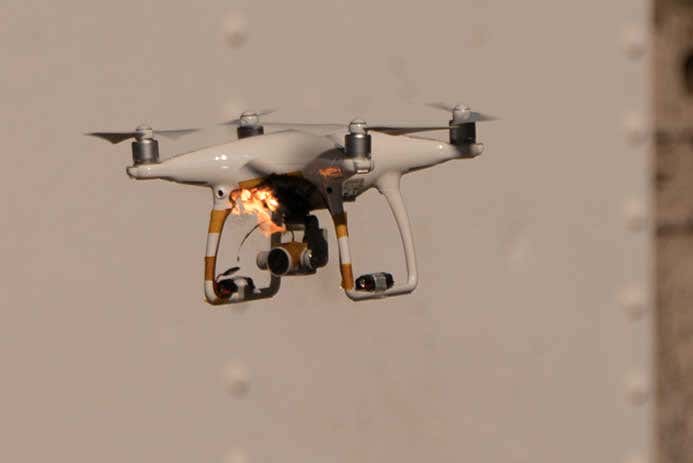
Raytheon Intelligence & Space's High Energy Laser weapon system mounted on a buggy seen disabling a small unmanned aerial vehicle during a test in New Mexico.
We have multiple techniques to overcome and sift through poor weather conditions, so it's less of an impact than one would think. We've developed a system that excels at electro-optically tracking very small targets in ground clutter because these drones are made to fly very low and in very difficult areas. Our system can often electro-optically track a low, slow-flying target, like a small drone, better than radar systems can. But severe weather conditions, severe fog, and severe humidity and moisture in the atmosphere, can degrade your track capability and increase your time to prosecute the entire engagement. That being said, our primary threat set right now, the small drone threat set, is also very reliant on electro-optical infrared sensors and not great at flying in very poor weather conditions. So most of the time you have a drone flying, we have the capability to track and destroy that drone.
In the worst-case scenarios, you may not be able to depend on the laser to finalize the hard kill of your threat. For that reason, we never advertise lasers as the end-all-be-all solution for an air defender. You want options and you want layers for different operation scenarios. But laser weapons are a key part of that layered defense. The Army has adopted this language. They call them ideal final protective fires assets.
About 80% of the time you'll be using the laser, which means you're on the right side of the cost curve. Your cost per engagement's small and your energy magazine is very deep. You also have the benefit of the sensor capability. But when the weather's really poor you might leverage the all-weather HPM or other capabilities, such as jamming or kinetic missile systems. One such kinetic missile system is Coyote, made by Raytheon Missiles & Defense, which is an optimized hybrid drone missile that's designed for killing drones for relatively low cost, and does so at very, very long ranges. Directed energy complements kinetic systems to create defense in depth.
Justin:
So, in terms of specific systems, can you give us an idea of the capabilities of Raytheon's high-energy laser weapon system (HELWS) and the latest iteration, HELWS2? What does it specifically bring to the table and how do you see a form of it operating on the modern battlefield going forward?
Evan Hunt:
We've been making iterative upgrades, rapidly prototyping these systems, and so each system we've built is a slightly upgraded version of the one prior. This has all happened in a very short time period. We started with software and fire control enhancements that just make the system easier to use, and have a big effect on how quickly you can prosecute an engagement. We use a gaming-style controller and a single laptop to prosecute the engagement.
We have multiple techniques to overcome and sift through poor weather conditions, so it's less of an impact than one would think. We've developed a system that excels at electro-optically tracking very small targets in ground clutter because these drones are made to fly very low and in very difficult areas. Our system can often electro-optically track a low, slow-flying target, like a small drone, better than radar systems can. But severe weather conditions, severe fog, and severe humidity and moisture in the atmosphere, can degrade your track capability and increase your time to prosecute the entire engagement. That being said, our primary threat set right now, the small drone threat set, is also very reliant on electro-optical infrared sensors and not great at flying in very poor weather conditions. So most of the time you have a drone flying, we have the capability to track and destroy that drone.
In the worst-case scenarios, you may not be able to depend on the laser to finalize the hard kill of your threat. For that reason, we never advertise lasers as the end-all-be-all solution for an air defender. You want options and you want layers for different operation scenarios. But laser weapons are a key part of that layered defense. The Army has adopted this language. They call them ideal final protective fires assets.
About 80% of the time you'll be using the laser, which means you're on the right side of the cost curve. Your cost per engagement's small and your energy magazine is very deep. You also have the benefit of the sensor capability. But when the weather's really poor you might leverage the all-weather HPM or other capabilities, such as jamming or kinetic missile systems. One such kinetic missile system is Coyote, made by Raytheon Missiles & Defense, which is an optimized hybrid drone missile that's designed for killing drones for relatively low cost, and does so at very, very long ranges. Directed energy complements kinetic systems to create defense in depth.
Justin:
So, in terms of specific systems, can you give us an idea of the capabilities of Raytheon's high-energy laser weapon system (HELWS) and the latest iteration, HELWS2? What does it specifically bring to the table and how do you see a form of it operating on the modern battlefield going forward?
Evan Hunt:
We've been making iterative upgrades, rapidly prototyping these systems, and so each system we've built is a slightly upgraded version of the one prior. This has all happened in a very short time period. We started with software and fire control enhancements that just make the system easier to use, and have a big effect on how quickly you can prosecute an engagement. We use a gaming-style controller and a single laptop to prosecute the engagement.
For this last system we're building for the Life Cycle Management Center, we're moving away from the dune buggy configuration, and we're taking that modular configuration and putting it into a palletized architecture so that it can be easily employed on the back of any commercial truck or on a building or tower.
Different customers want different vehicles. The Polaris MRZR's been a fantastic option just for easy transport – and it's loved by the armed force – but ultimately I think we'll end up putting laser weapons on a number of different vehicle types. So the palletized architecture was part of that.
Justin:
You mentioned magazine depth—to what extent does the magazine depth, in a continuous engagement context at least, degrade as you move down to smaller and smaller classes of vehicles? Because obviously often the ‘unlimited’ magazine depth is often put forward as one of the key advantages of directed-energy weapons, but that's usually in the context of a maritime or a fixed-based defense capability where you have a huge power source and lots of space for capacitors. So, how much of a trade-off would customers get if they're trying to move down to either a palletized form or even potentially those smaller dune buggy type applications?
Evan Hunt:
If you look at the amazing advancements in the hybrid and electric vehicles and the increased range in, for example, the latest Tesla's, it gives you an idea of the rate of advancement we've got in our lithium-ion battery energy magazine. The first system we built had enough energy magazine for 20 to 30 drones, for example, and now we have 40 to 50 drones-worth in a single magazine. Then you can just plug that magazine into any standard generator and recharge it in roughly half an hour. You have virtually unlimited power and, unlike other weapon systems like missiles or ammunition systems, you don’t have to transport the ammo.
Justin:
Hopefully, the adversary runs out of UAS before you run out of shots?
Evan Hunt:
That's the real trick. The biggest problem with the swarm is just how many targets there are. So, you can get overwhelmed, and that's why directed energy is so compelling.
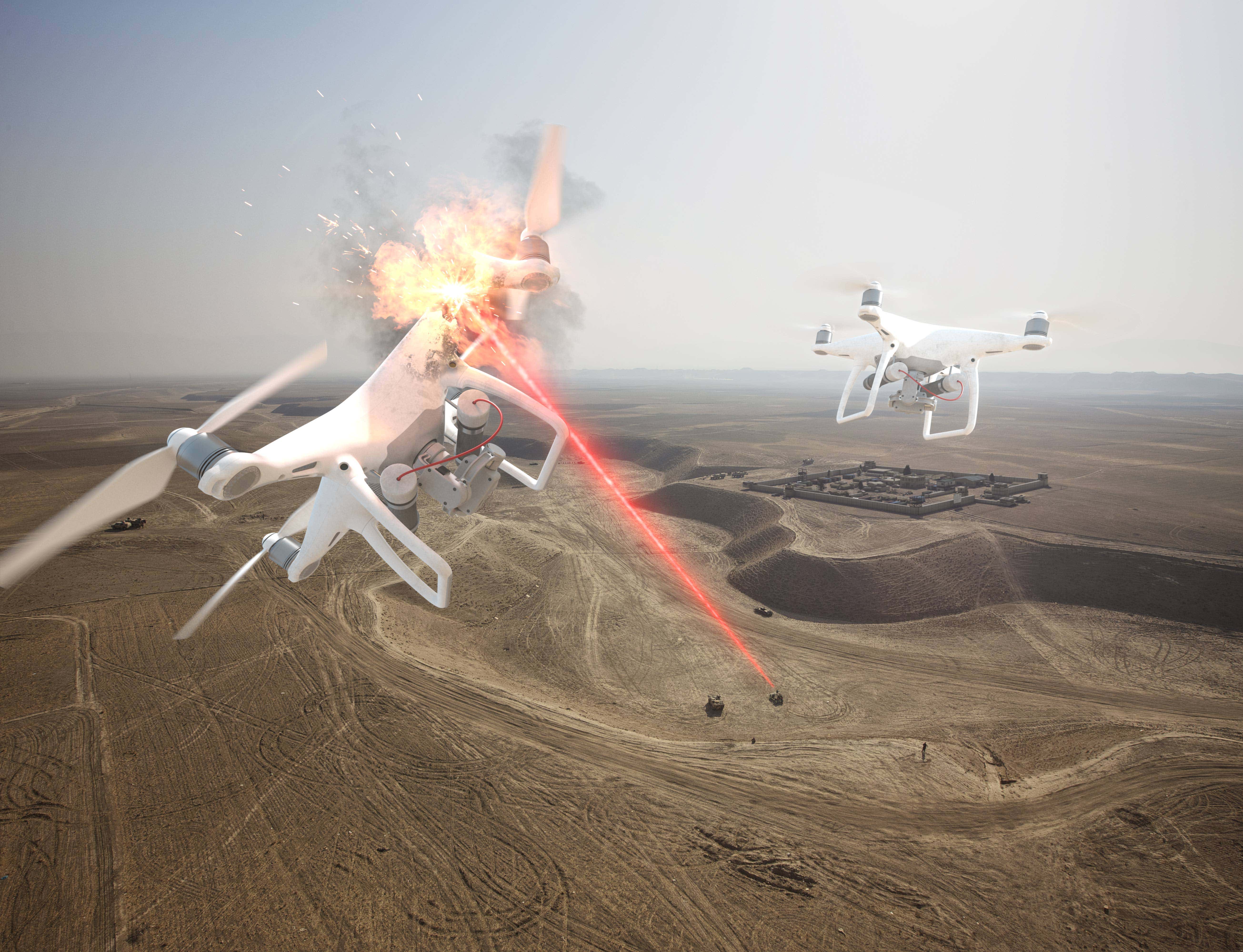
Justin:
High Energy Laser Weapon System 2 (HELWS2) seems to be squarely marketed at the counter-UAS mission, which you've mentioned a lot. It's clearly a very real concern at the moment, a very live concern to the militaries all over the world. Presumably, you've seen an active interest in this system from multiple service branches in the US, but also from international customers. What do you see is the overall market for this sort of system?
Evan Hunt:
I think there's a compelling multi-service and global market associated with counter-drone technology, and right now there's a technology race for what is the best counter-drone technology. You have everything from net-thrower drones to handheld jammers and larger omni-directional jammers, gun and missile systems, lasers and high power microwaves – all being developed and trying to prove their worth. In my view, the laser is, for a mature air defender, one of the most optimized solutions for a final protective fires mission. That’s because it gives you the positive identification capability you need. It gives you the hard-kill capability you need and it does so in a relatively undisruptive manner. You don't have explosions. Yet you can engage highly maneuvering, difficult targets even in clutter at tactically significant ranges. There are very few of those systems that I mentioned that actually meet all those categories. In fact, maybe none but HELs.
Justin:
On that subject, could the HELWS2 in its current form be capable of other SHORAD tasks that are currently covered by other kinetic systems such as C-RAM (counter-rocket, artillery, and mortar) against things like attack aviation, perhaps even counter-missile defense? And if not a system along the lines of HELWS2, what sort of directed-energy weapon systems do you envisage playing in that kind of mission set?
Evan Hunt:
We look at the laser market in a few different categories. This 10-kilowatt class is really a counter-small-drone market. A step up is the 30 to 50-kilowatt class, which is really designed for not only small drones at longer ranges, but also potentially Group 3 drones, cruise missiles, rocket artillery and mortars. For the US Army Rapid Capabilities and Critical Technologies Office (RCCTO), we've built a 50-kilowatt class laser weapon subsystem that's getting integrated onto a Stryker vehicle as a combat prototype for what could potentially become a part of the Mobile Short-Range Air Defense (M-SHORAD) program of record for a much broader target set than just drones.
Right now there's a tentative plan to build many more vehicles within the decade for the M-SHORAD program, based on Stryker vehicles, and the vision is that if our demonstrator which we're going to demonstrate this summer is successful, then a portion of the vehicle component will be directed-energy variants that carry 50-kilowatt class laser weapons on them. So the Army has adopted this same vision of a layered defense and a complimentary laser and kinetic capability, not just for drones, but for the full target set.
Justin:
Is the 50-kilowatt class laser on Stryker for the M-SHORAD project a fundamentally different proposal from HELWS2 and does it present its own new challenges, or is it very much a growth of the existing architecture on similar lines?
Evan Hunt:
I would say it's a growth. Part of what's made us so successful so far on the M-SHORAD development is that we had the ability to directly scale many of the pieces and parts from the HEL weapon system that we built for Counter-UAS. The lithium-ion battery technology is directly scalable. The fiber laser beam combination technology is directly scalable. The fire control architecture of the software is virtually the same. So, the only major thing that was a real step up was a larger class of beam director, which frankly is part of the same product family as the smaller beam director we built for the high-energy laser weapon system. We're talking about technology that has been proven overseas already, and now we're just scaling it up.
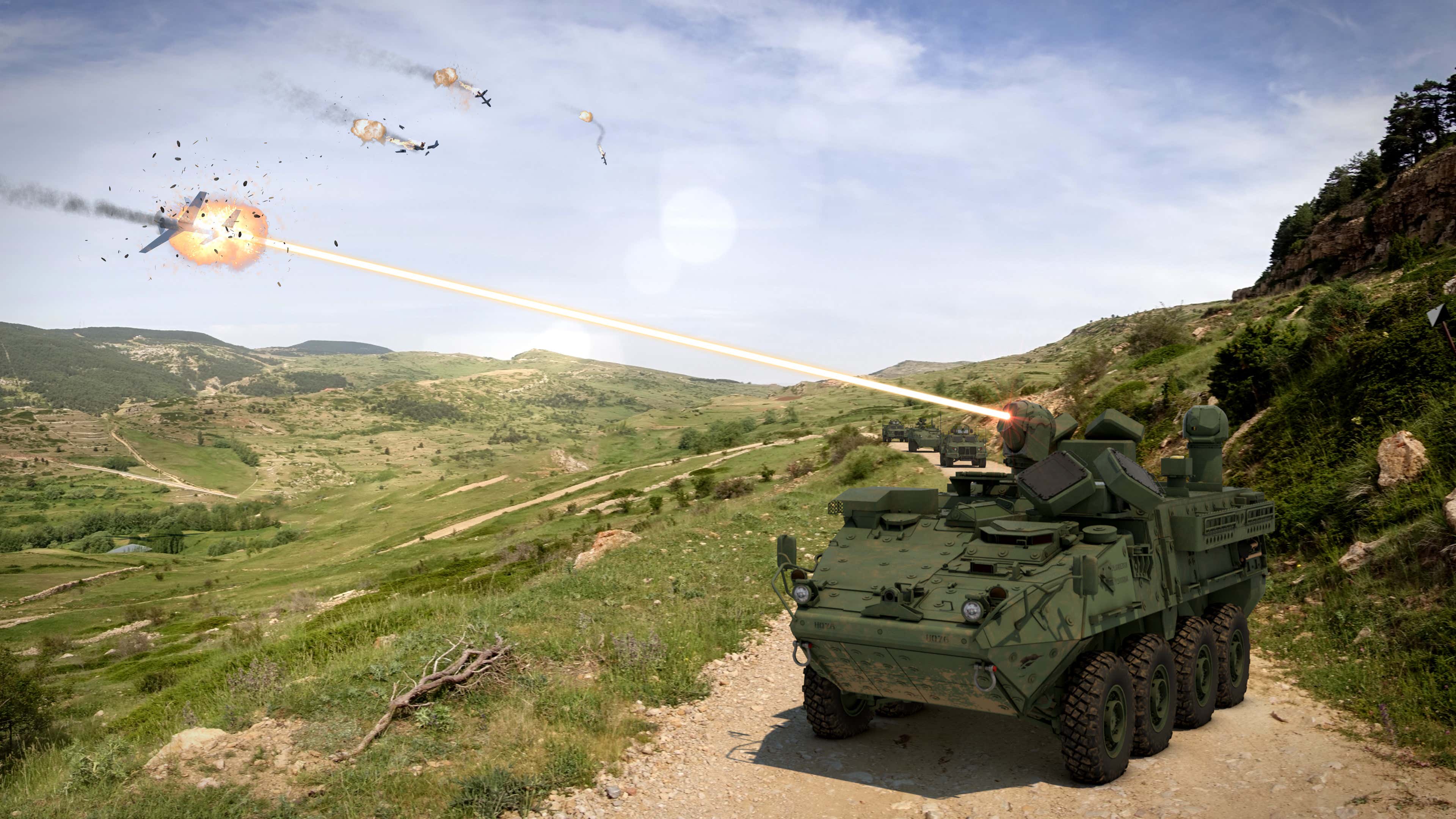
What are the similarities and differences between HELWS and the PHASER high-powered microwave weapon system? When do you want a laser and when do you want an HPM? And do you see these two types of directed energy complimenting each other on the battlefield, particularly when it comes to defeating drone swarms?
Evan Hunt:
The Army calls HELs serial killers, because they engage one thing at a time. I think of them as similar to a sniper rifle. When you're engaging something incredibly precisely, you use a laser. An HPM has the capability to emit a burst and disable a bunch of drones flying in a tightly packed swarm. So in certain operational contexts having both complementing each other makes a lot of sense. Both are compelling counter-swarm technologies.
I'll give you an example. You might have a few drones pop up from a nearby residential building that is flying near an airport tower or flying along a highway with commercial vehicles on it. In those types of scenarios, you'll probably want to use the laser because you don't want to disable certain other digital technologies. And in some cases, you're out protecting a forward operating base and you have a swarm coming in. Well, then it's kind of all hands on deck and you're going to use everything you can use and you don't have to worry about collateral effects.
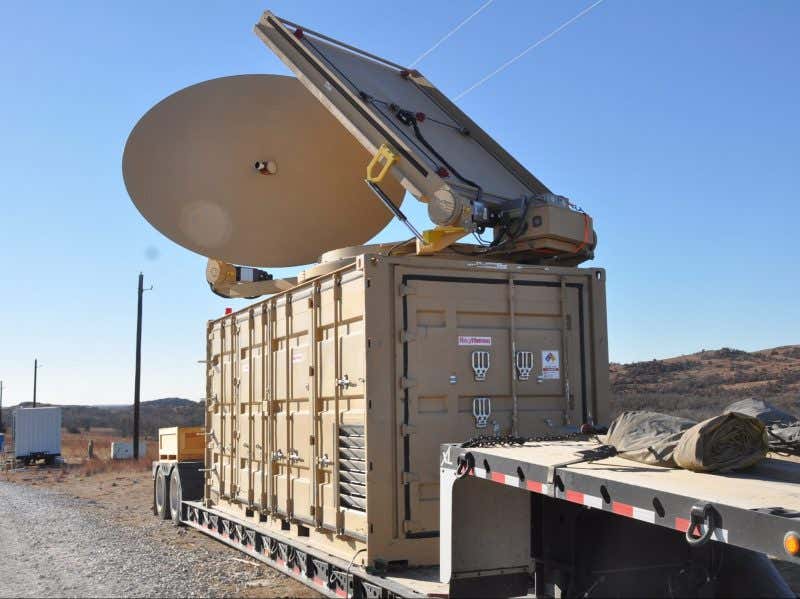
Justin:
Raytheon has been test-flying a HEL weapon system in a pod slung under an Apache’s stub wing. It's really the first we've seen of an airborne compact laser weapon on a rotary-wing platform. Can you elaborate on how you see, perhaps, attack aviation using such a system on the battlefield, and any updates that you might be able to give us on where that program stands and where it's going?
Evan Hunt:
We did a lot of testing under a cooperative research development agreement with the U.S. Army Apache Program Management Office and U.S. Special Operations Command to prove that lasers were viable for those types of platforms, such as Black Hawks and Apache platforms. By viable, I mean that they could survive under strong vibration conditions, that they could hold their aim point on targets despite those vibration conditions and despite turbulence. I think that was a very successful collaboration with the US government.
All the HEL subsystem technologies are advancing at a very rapid rate, so I would expect that there is a future for lasers in aviation. But I think our goal right now is to demonstrate on the ground first, and transition these technologies to production for both counter-UAS and M-SHORAD, and then we'll see what's next.
Justin:
On the naval side of things, where of course SHORAD and counter-UAS is also a big concern at the moment, there has in the past been some talk of creating a laser Phalanx. So, you'd use some of the proven close-in weapon system’s sensor and aiming components, and then pair that with a HEL rather than the 20mm cannon. Is this still a potential concept, and where do you see directed-energy is best applied in the naval domain?
Evan Hunt:
The Navy is very serious about higher power high-energy lasers on service Navy platforms. They aren't just concerned with drones though. They're concerned with the full target set, like the SHORAD target set or even higher power. I think ideally the Navy wants to be able to deal with all their threats with the laser. Raytheon has focused to date on moderate power systems that can be transitioned most quickly to the warfighter, but we are now turning our attention to higher power systems
The Navy was also really the first program office or first element of the DoD to invest heavily in getting a demonstrator overseas, and that was the USS Ponce demonstrator. It was a 30-kilowatt class system, and from there they moved out pretty quickly with a few programs to build greater than 50 kilowatt systems on ships.
Justin:
There has also been discussion around using laser weapons for defense both in naval but also in a land-based context against really high-end targets, particularly ballistic missiles. Do you see either HEL as promising technologies for defending key targets against ballistic missiles specifically during terminal attack phases?
Evan Hunt:
Well, in the early 2000s the Department of Defense built something called the Airborne Laser program. The DoD invested a lot of money and we did build a megawatt-class laser weapon that was capable of engaging target sets like that at significant range. It wasn't packaged in a form that was really logistically viable, but a lot of the developments we've made in recent history draw upon industry expertise that was developed in those days.
I think at a theoretical level, laser weapons and directed energy, in general, make perfect sense for high-flying fast targets, ballistic missiles or maybe even supersonic threats. If you have to engage targets in a cost-effective and precise manner, and even targets that are flying faster than the speed of sound, where you might even have to engage them from behind…well the best way to do that is with an effector that moves at the speed of light.
But we have a long way to go. We have to demonstrate that we can build laser weapons of a sufficient power class in logistically viable form factors that are capable of dealing with those target sets. Our approach has always been to prove we can deal with the less complex threats first, and prove that the laser weapons are ideally matched for those. Then that technology will transition into higher-powered developments for the other target sets.
Justin:
You mentioned the advantage that HELs have in the targeting process, in the fact that they are essentially optics and can continue to function in that role while being HEL effectors. What approach is Raytheon taking to HEL in terms of the challenges of integration within the broader recognized air picture, and within the sensor-shooter targeting architectures that both the US Air Force and the broader DoD are trying to set up?
Evan Hunt:
Our whole goal has been to deliver a weapon system that is mature and capable of fully integrating with DoD customer architecture. We actually have already integrated the HELWS with established mature baselines for Command and Control. So our systems are already integrated and feeding that integrated air picture now.
We also team very closely with the KuRFS radar business unit within Raytheon Missiles & Defense. K-band radars have a lot of fantastic capability for detecting and tracking small drones. So, many of our systems have been delivered and are actually being used with K-band radars on the network right now.
Justin:
Coming to the end of the interview, one of the outstanding questions I had was; what are the main challenges and roadblocks that you see still outstanding between where DEW is today and a future where DEW is a commonplace weapon system seen on the battlefield in the various domains?
Evan Hunt:
There's been a lot of focus within the Air Force and the Army on building combat prototypes. That has allowed us to really build with ingenuity at Raytheon, where the folks building the system can make the appropriate trades internally to not just have a beam fire for a certain number of seconds, but to ensure that the whole system that's delivered to the warfighter, is as optimized as possible. There has been great progress from the Department of Defense acquisition strategy to allow this technology to move forward by building combat prototypes that aren't so specific in their requirements.
At the same time, the HELWS – a full weapon system that is in the hands of operators – was developed on Raytheon’s internal investment. So, when we have robust funding profiles and outlooks for transition of production, the entire industry supply base will have the security they need to make big investments and to drive the technology forward.
I think the biggest roadblock remains funding. Although a lot of money has been invested in laser weapons, it pales in comparison to the DoD budget as a whole. If we're very serious about directed-energy technology being a key part of national defense strategy and getting on the right side of the cost curve and dealing with asymmetric threats, then we need to get serious about the transition of the technology. I think the Army and the Air Force have been, together with Raytheon, leading from the front in that regard.
Justin Bronk
No comments:
Post a Comment
Note: Only a member of this blog may post a comment.